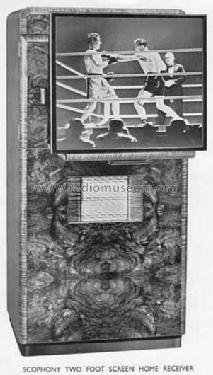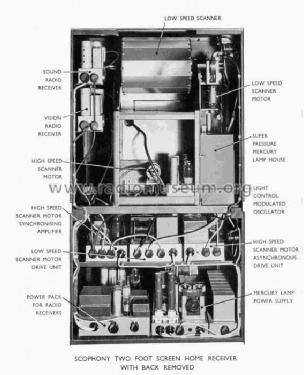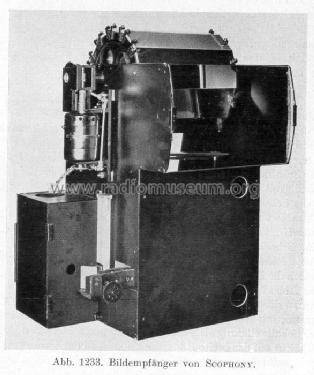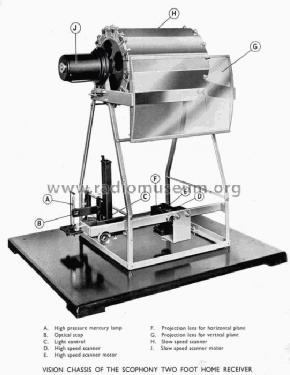Scophony Home-Receiver ES104
Scophony Ltd.; London
- Country
- Great Britain (UK)
- Manufacturer / Brand
- Scophony Ltd.; London
- Year
- 1938
- Category
- Television Receiver (TV) or Monitor
- Radiomuseum.org ID
- 102524
- Number of Tubes
- 39
- Valves / Tubes
- Wave bands
- Wave Bands given in the notes.
- Power type and voltage
- Alternating Current supply (AC)
- Loudspeaker
- Permanent or electro-dynamic (moving coil), system not known yet.
- Material
- Wooden case
- from Radiomuseum.org
- Model: Scophony Home-Receiver ES104 - Scophony Ltd.; London
- Notes
-
The Scophony home receiver gives a projected picture 24" x 20" of very pleasant black and white colour.
This picture is nearly five to six times larger In area than the pictures at present obtainable with the bigger direct view cathode ray tube type of receiver and can be satisfactorily seen by a number of people Simultaneously.
GENERAL
The total number of valves at present used In the Scophony large screen home receiver Is 39 Including all rectifiers, and the Mercury lamp power supply.
The set was mechanical, using a mirror drum 12 inches in diameter, a miniature polygon of stainless steel rotating at 30,375 rpm, with a 300-watt mercury lamp. Separate sound and picture receivers (1 channel on 45 MHz). 1000W power consumption.
CONTROLS
The controls are essentially simple. Sarting by means of a delayed push button switch. This switches on all filaments, power supplies, and mercury lamp.
There Is one control for sound volume and one control for vision gain, which controls the: contrast.
Another control is provided for picture brightness.On the scanners, there Is one-speed control with synchronising locking switch and one for frame adjustment. A focus control knob Is also provided for the purpose of occasional adjustments.
Two of the fundamental Inventions Incorporated In the home receiver which result in a far greater light efficiency than has hitherto been possible, are the Split Focus and the Supersonic Light Control.
Brief descriptions of these are given below.
THE SPLIT FOCUS
Is an optical arrangement of cylindrical lenses with their axes crossed so that a beam of light is focused In two separate planes. An advantage of the split focus is that where optical scanners are employed, they can be of a considerably smaller size than would be essential with ordinary spherical lens systems: or vice versa, with the same size of scanner a considerably greater aperture of the optical system can be usefully employed. For Instance, without the split focus, the scanner In the Scophony Home Receiver would have to be at least twelve times larger.
THE SUPERSONIC LIGHT CONTROL
Present-day television reception is hampered by the necessary loss of light through "scanning", as is well known, In the normal way the picture is scanned by a single spot, whether it be at the transmitter or the receiver. This spot has to traverse the whole picture in a particular time.
If the scanned area of the picture consists of 405 lines. each containing 540 picture elements, then the whole picture can be considered as made up of approximately 200,000 elements.Consequently, we can only obtain one, two hundred thousands of the light obtainable when the whole of the picture Is simultaneously Illuminated with the same intensity as the single spot. I.e. under conditions where no scanning Is employed, as incinema projectors. This great light deficiency has been overcome by the Invention of the Scophony light control.
Manufactured by EKCO.
- Source of data
- -- Collector info (Sammler)
- Mentioned in
- -- Original-techn. papers. (Scophony 1938 - Early Television Foundation - Tom Genova)
- Author
- Model page created by Georg Richter. See "Data change" for further contributors.
- Other Models
-
Here you find 4 models, 4 with images and 0 with schematics for wireless sets etc. In French: TSF for Télégraphie sans fil.
All listed radios etc. from Scophony Ltd.; London



